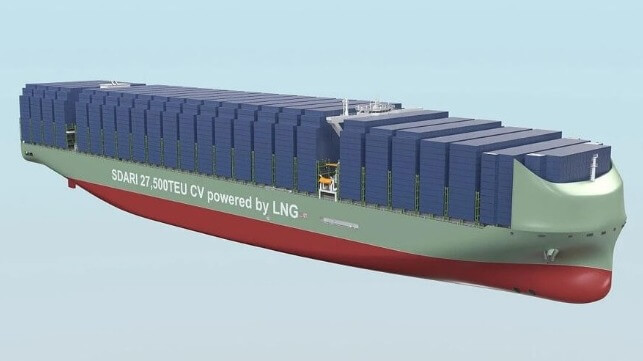CSSC’s SRDI Unveils Record-Breaking 27,500 TEU Containership Design

China is taking the race for ultra-large containerships (ULCS) to another level, with a design concept for a 27,500 TEU LNG dual-fuel boxship. The design was revealed and received Approval in Principle (AiP) at the SMM Hamburg Maritime Exhibition this week.
The design concept for the vessel named Green Sealion was developed by Shanghai Ship Research and Design Institute, a subsidiary of the state-owned China State Shipbuilding Corporation (CSSC). If built, the 27,500 TEU vessel would become the world’s largest containership (by capacity). While several of the major carriers, including MSC, OOCL, and ONE, have all broken the 24,000 TEU hurdle, ONE (Ocean Network Express) claimed the record for loading the high number with five successive vessels between November 2023 and January 2024 in Singapore. They topped out at just over 22,200 boxes when the ONE Intelligence departed Singapore.
Since 2010, ULCS have started to become popular in liner shipping, offering the advantages of economies of scale, which have helped reduce costs per TEU transported. The largest ships, so far, are limited to the routes between Asia and Europe, limited in dimensions by the Suez Canal and port capacity in Northern Europe.
The Green Sealion is being promoted as taking maritime efficiency to a higher step. Its rated capacity would be 15 percent higher than the current ultra-large vessels. According to the developer, the vessel features an optimized hull design and LNG dual-fuel propulsion, aligning with IMO regulations on the reduction of carbon intensity. The vessel will also have a connection for shore power. No dimensions were announced.
Besides the Green Sealion 27500, the developer also unveiled other smaller series. These include the Green Sealion 20000, which is a 20,000 TEU ammonia dual-fuel containership. The other one is Green Sealion 16000, an LNG dual-fuel boxship with a capacity of 16,000 TEU.
These landmark designs highlight China’s efforts to expand in the construction of high-value next-generation containerships. China seeks to challenge the South Korean shipyards which have declared a strategy of focusing on high-value ships, new technologies including automation, and future fuels including ammonia. Traditionally, South Korean and Japanese yards have dominated the construction of LNG-powered vessels, but more recently Chinese yards scaled up orders for alternate fuel vessels.
Last year, the Chinese Ministry of Industry and Information Technology released a seven-year plan to dominate in green shipbuilding market. This entails China developing supply chains for faster delivery of alternate fuel ships. The plan also included a roadmap to accelerate R&D on ammonia and methanol-powered propulsion as well as other emerging options.
